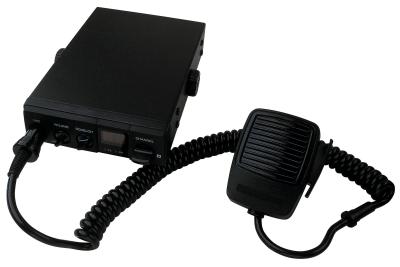
Citizen's Band (CB) radio communications is a popular pastime, enhanced by the participants' ability to hear distant transmissions and reply to them. The CB radio's range is extended by using several techniques, the most important being correct installation. Improperly applied equipment can reduce the effective range by more than 75%, from over 5 miles to less than 2. The correct antenna, cabling, power tap, and grounding allow for proper radio wave propagation. The average radio enthusiast can maximize a radio's output and reception in about an hour.
Mount the antenna securely to the vehicle, away from other antennas. Magnetic-mount and glass-mount antennas are not suited to CB radio wave propagation; the best antenna to install is a "steel whip" style 1/4 wave antenna. While the others may be easier to install and less obtrusive, the 1/4 wave whip will extend range considerably. Other antennas, such as cellular or AM/FM radio antennas, will interfere with the waveform emanating from the CB antenna. Placing the mount away from these will increase range.
Secure a ground wire to the base of the antenna mount, attached to the body of the vehicle. Strip a 2- or 3-foot section of 14-gauge wire at both ends and loop one end around a mount bolt at the base of the antenna. Locate a suitable ground on the body or frame of the vehicle; normally this is a screw or bolt that makes solid contact. Loop the open end of the wire around the screw and turn it clockwise firmly until the wire is pinched in between the screw and the body/frame. This wire will ground the antenna, increasing reception and eliminating background noise.
Make sure the antenna cable's insulation is intact and is not exposed to the body of the vehicle, especially where the cable bends around corners. Open cable elements can ground out, causing a severe reduction in range and possibly damaging the radio equipment during transmission. Cover any exposed areas with electrical tape, wrapped tightly around the damaged section.
Use shielded antenna cable during installation. The standard RG58 cable comes in a variety of subtypes, including Mini 8, RG58X, and others. Most RG58 has limited shielding, but can "leak" during transmission or be susceptible to the vehicle's electrical system (background noise). Shielded cable has extra metallic insulation protecting it from outside interference and will extend range by eliminating noise.
Install 18 feet of antenna cable, even if it exceeds the length necessary for reaching from the radio to the antenna. CB radios are the most efficient when 18 feet of cable is used -- as most equipment is set up to use this length -- and it propagates better than other lengths. Two sections of 9-foot cable can be joined together, but using one continuous section is preferred.
Check the cable adapter plugs for screw-type couplers, and replace the cable if the plugs are "push" style. Inexpensive cables can have simple couplers that are pushed onto the antenna connector of the radio and antenna mount, but they often become loose and do not make good connections with the terminals. Remove the cable and install an RG58 cable with screw-in couplers for a more secure connection.
Isolate the radio from the vehicle's electrical system by connecting the radio directly to the battery. Run a length of 14-gauge wire from the positive terminal on the battery to the radio and strip the insulation from both ends. Unscrew the battery terminal from the post by turning it counterclockwise with pliers, then wrap the wire around it and secure it back to the battery post by turning it clockwise until tight. Splice the other end to the radio's power wire and wrap it tightly with electrical tape. Repeat this procedure for the negative terminals. The vehicle's power systems can interfere with reception, and isolating them from the radio will increase range.
Install a "linear" power amplifier to the radio system. These devices were popular in the 1970s and can boost transmission and reception range by five or six times. Unscrew the antenna cable from the radio, install the antenna side to the output of the linear amplifier, then install another section of cable from the radio to the input side of the amp. Run a section of 14-gauge wire for the positive and negative power leads on the amplifier, stripping and splicing the wires to the positive and negative posts on the battery as described in the above step. Linear amps are intended for ham radio use, so check local laws before making this modification.
Install a capacitor to the positive power lead on the radio. This is commonly used in car audio setups to provide "clean power" to the equipment, eliminating noise. Cut the positive power lead on the radio and strip both ends of the wire. Connect the ends to the leads provided on the capacitor and splice them together, insulating them with electrical tape. Most capacitors designed for this purpose may have more than two leads, so check the instruction manual for proper installation.